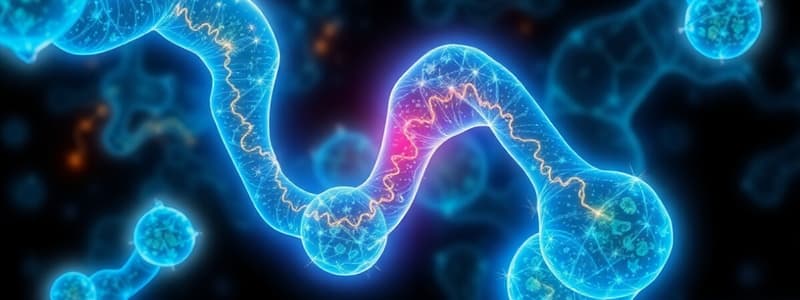Podcast
Questions and Answers
What defines the specificity of an enzyme?
What defines the specificity of an enzyme?
- The presence of coenzymes or cofactors
- The quantity of the substrate present
- The amino acid sequence and three-dimensional shape of the enzyme (correct)
- The temperature at which the reaction occurs
What is the term for the process that allows the enzyme to adjust its shape for better substrate interaction?
What is the term for the process that allows the enzyme to adjust its shape for better substrate interaction?
- Enzyme stabilization
- Induced fit (correct)
- Active site remodeling
- Substrate orientation
Which of the following statements about enzymes is incorrect?
Which of the following statements about enzymes is incorrect?
- Enzymes lower the activation energy required for reactions.
- Enzymes can catalyze reactions in both directions.
- Enzymes work best at a fixed temperature for all reactions. (correct)
- Enzymes are not consumed in reactions.
What role do the R groups of amino acids play at the active site of an enzyme?
What role do the R groups of amino acids play at the active site of an enzyme?
What primarily holds substrates in the active site of an enzyme?
What primarily holds substrates in the active site of an enzyme?
What is the significance of a negative ΔG in a chemical reaction?
What is the significance of a negative ΔG in a chemical reaction?
Which of the following correctly describes the role of ΔG in an endergonic reaction?
Which of the following correctly describes the role of ΔG in an endergonic reaction?
What is the relationship between cellular respiration and photosynthesis regarding energy?
What is the relationship between cellular respiration and photosynthesis regarding energy?
Why do cells maintain metabolic disequilibrium?
Why do cells maintain metabolic disequilibrium?
How does the process of cellular respiration relate to free energy differences?
How does the process of cellular respiration relate to free energy differences?
What is the function of an enzyme in metabolic reactions?
What is the function of an enzyme in metabolic reactions?
What represents the free energy of activation in a chemical reaction?
What represents the free energy of activation in a chemical reaction?
Which mechanism underlies the action of enzymes in breaking down substrates like sucrose?
Which mechanism underlies the action of enzymes in breaking down substrates like sucrose?
Why do some spontaneous reactions proceed very slowly at room temperature?
Why do some spontaneous reactions proceed very slowly at room temperature?
What happens when sufficient energy is absorbed by reactant molecules during a reaction?
What happens when sufficient energy is absorbed by reactant molecules during a reaction?
What happens to substrate binding at low concentrations?
What happens to substrate binding at low concentrations?
What is the effect of high substrate concentrations on enzyme reactions?
What is the effect of high substrate concentrations on enzyme reactions?
How does temperature influence enzyme activity?
How does temperature influence enzyme activity?
What role do R groups in the active site play during enzymatic reactions?
What role do R groups in the active site play during enzymatic reactions?
What leads to enzyme denaturation at elevated temperatures?
What leads to enzyme denaturation at elevated temperatures?
Flashcards
Exergonic Reaction
Exergonic Reaction
A chemical reaction that releases energy into the surroundings, resulting in a negative change in free energy (ΔG).
Endergonic Reaction
Endergonic Reaction
A chemical reaction that absorbs energy from its surroundings, resulting in a positive change in free energy (ΔG).
Metabolic Equilibrium
Metabolic Equilibrium
The tendency of a reaction to proceed toward equilibrium, a state where the rates of forward and reverse reactions are equal. Living systems maintain disequilibrium to perform work.
Catabolic Process
Catabolic Process
Signup and view all the flashcards
Metabolic Disequilibrium
Metabolic Disequilibrium
Signup and view all the flashcards
Activation Energy (EA)
Activation Energy (EA)
Signup and view all the flashcards
Transition State
Transition State
Signup and view all the flashcards
Enzyme
Enzyme
Signup and view all the flashcards
Catabolic Pathway
Catabolic Pathway
Signup and view all the flashcards
Anabolic Pathway
Anabolic Pathway
Signup and view all the flashcards
What is a substrate?
What is a substrate?
Signup and view all the flashcards
What is the active site?
What is the active site?
Signup and view all the flashcards
What is induced fit?
What is induced fit?
Signup and view all the flashcards
How do enzymes speed up reactions?
How do enzymes speed up reactions?
Signup and view all the flashcards
Why are enzymes specific?
Why are enzymes specific?
Signup and view all the flashcards
Active Site
Active Site
Signup and view all the flashcards
Induced Fit
Induced Fit
Signup and view all the flashcards
Enzyme Saturation
Enzyme Saturation
Signup and view all the flashcards
Optimal Temperature
Optimal Temperature
Signup and view all the flashcards
Enzyme Denaturation
Enzyme Denaturation
Signup and view all the flashcards
Study Notes
Chapter 8: An Introduction to Metabolism
-
Metabolism is the sum total of an organism's chemical reactions, which transforms matter and energy, subject to the laws of thermodynamics. It's an emergent property of life.
-
Metabolic pathways are a series of defined steps that alter a specific molecule to produce a specific product. Each step is catalyzed by a specific enzyme.
-
Catabolic pathways break down complex molecules to simpler ones, releasing energy. Cellular respiration is a major catabolic pathway that breaks down glucose for energy (glucose + oxygen → carbon dioxide + water.)
-
Anabolic pathways, also known as biosynthetic pathways, consume energy to build complicated molecules from simpler ones. Examples include the synthesis of amino acids and proteins.
-
Energy released from catabolic pathways powers anabolic pathways.
Energy Transformations
-
Energy is the capacity to cause change. Kinetic energy is energy associated with motion (e.g., thermal energy); potential energy is energy that matter possesses due to its location or structure (e.g., light, chemical energy). Chemical energy is potential energy available for release in chemical reactions.
-
Thermodynamics studies energy transformations. An isolated system doesn't exchange energy or matter with its surroundings; an open system does. Organisms are open systems.
-
The first law of thermodynamics states that energy cannot be created or destroyed, only transferred or transformed.
-
The second law of thermodynamics states that every energy transfer or transformation increases the entropy (disorder) of the universe.
-
Spontaneity is the tendency of a process to occur without external influence. Spontaneous processes increase the entropy of the universe. An exergonic reaction is a spontaneous chemical reaction that releases free energy (negative ΔG), while an endergonic reaction is a nonspontaneous reaction requiring an energy input (positive ΔG). Reactions are reversible when at equilibrium (ΔG=0).
Enzymes
-
Enzymes are biological catalysts that speed up metabolic reactions by lowering the activation energy (EA) needed for a reaction, required for reactants to reach a transition state, without being consumed.
-
Enzymes are substrate specific, meaning they bind to specific substrates and their reaction occurs at a specific region: the active site.
-
Induced fit describes the change in shape of an enzyme as it binds to a substrate (interactions between chemical groups, resulting in a more favorable orientation for the reaction). This brings the active site's chemical groups into the optimal position to catalyze the reaction.
Enzymes and Metabolic Control
-
Metabolic enzymes are controlled via allosteric regulation, where a regulatory molecule binds at a site other than the active site, thus changing enzyme shape to either inhibit or stimulate its activity.
-
Feedback inhibition occurs when an end product of a metabolic pathway stops an earlier enzyme, preventing overproduction. Cells compartmentalize pathways to regulate metabolism.
-
Other regulatory mechanisms include the location of enzymes within membranes or organelles.
Studying That Suits You
Use AI to generate personalized quizzes and flashcards to suit your learning preferences.




